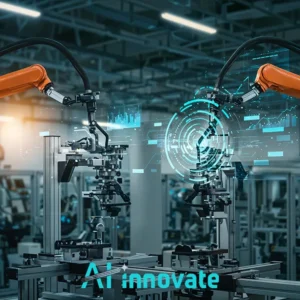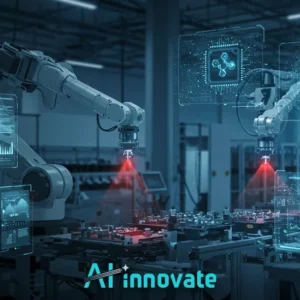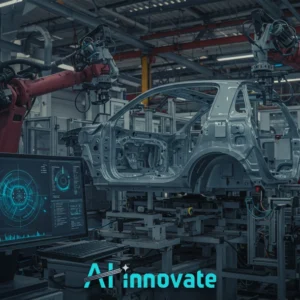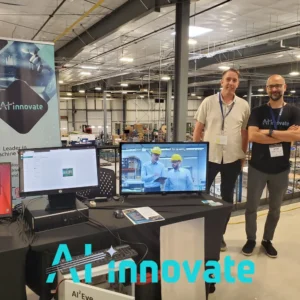The modern manufacturing floor operates on margins of precision that leave no room for error. While traditional quality control has served its purpose, it cannot meet the demands of high-speed, complex production environments where micrometre-level accuracy is the baseline. Reliance on legacy methods introduces variability and blind spots.
At AI-Innovate, we partner with industry leaders to transcend these limitations. This article will guide you through the strategic shift from simple fault finding to a holistic, data-driven approach, demonstrating how to harness intelligent systems for profound and continuous process enhancement.
The Cascade Effect of Flaws
A single undetected defect is rarely an isolated incident; it is the starting point of a value-draining cascade. An imperfection that escapes initial inspection does not simply represent the cost of one faulty unit.
It triggers a series of hidden liabilities that ripple through the entire value chain, eroding profitability and competitive standing. This is a primary challenge in defect detection in manufacturing, where the consequences extend far beyond the factory walls.
Before a product even leaves the facility, resources are consumed by manual reinspection, production is halted for troubleshooting, and delivery timelines are compromised. The true cost, however, accumulates downstream.
These seemingly minor flaws are the seeds of major financial and reputational damage. The impact manifests in several critical areas:
- Brand Erosion: Every faulty product that reaches a customer chips away at hard-won brand trust and loyalty.
- Warranty Claims: The direct cost of replacing or repairing defective goods creates a significant and often unpredictable financial burden.
- Production Bottlenecks: The need to investigate and contain quality escapes disrupts the operational rhythm, leading to systemic inefficiency.
From Pass/Fail to Process DNA
Traditional inspection systems were designed solely for a simple binary decision of pass or fail. While this approach is straightforward, it discards a wealth of valuable operational intelligence.
The modern paradigm of Machine Learning for Manufacturing Process Optimization, however, reframes every inspection event as an opportunity. It captures the unique “digital DNA” of the production process at that precise moment.
Instead of a simple red or green light, we gain access to a rich, quantitative dataset that describes the “what, where, and how” of every anomaly. This granular telemetry is the very bedrock of intelligent manufacturing.
This transformation in data granularity enables sophisticated defect analysis techniques that were previously impossible.
|
Traditional Output (The Symptom) |
AI-Driven Data (The Diagnosis) |
|
Simple Pass/Fail Result |
Precise Defect Coordinates and Location |
|
Subjective Description (“scratch”) |
Quantitative Metrics (Length, Depth, Area) |
|
Batch-Level Rejection |
Correlation with Specific Machine Parameters |
|
Delayed Manual Report |
Real-Time Data for Immediate Intervention |
The Paradigm Shift in Quality Data Granularity
Precision at Production Speed
This is where theory meets the unrelenting pace of the factory floor. The true power of machine vision for defect detection is its ability to deploy superhuman analytical precision without creating a bottleneck.
To achieve this, sophisticated neural networks process immense visual data streams in real-time. They identify complex flaws that are functionally invisible to human inspectors, a particular challenge over long, fatiguing shifts. The applications for this technology are as diverse as manufacturing itself.
- Printed Circuit Boards (PCBs): Identifying microscopic solder bridges, validating component polarity, and detecting trace inconsistencies that determine the functional viability of electronic devices.
- Precision-Machined Parts: Detecting sub-surface porosity or hairline stress fractures in critical metal components, which can be precursors to catastrophic structural failure.
- Plastic Injection Molding: Pinpointing subtle warpage, sink marks, or short shots in complex 3D parts, ensuring both aesthetic quality and dimensional accuracy.
- Automotive and Aerospace Welds: Verifying the geometric conformity and structural integrity of weld beads and solder points where reliability is non-negotiable.
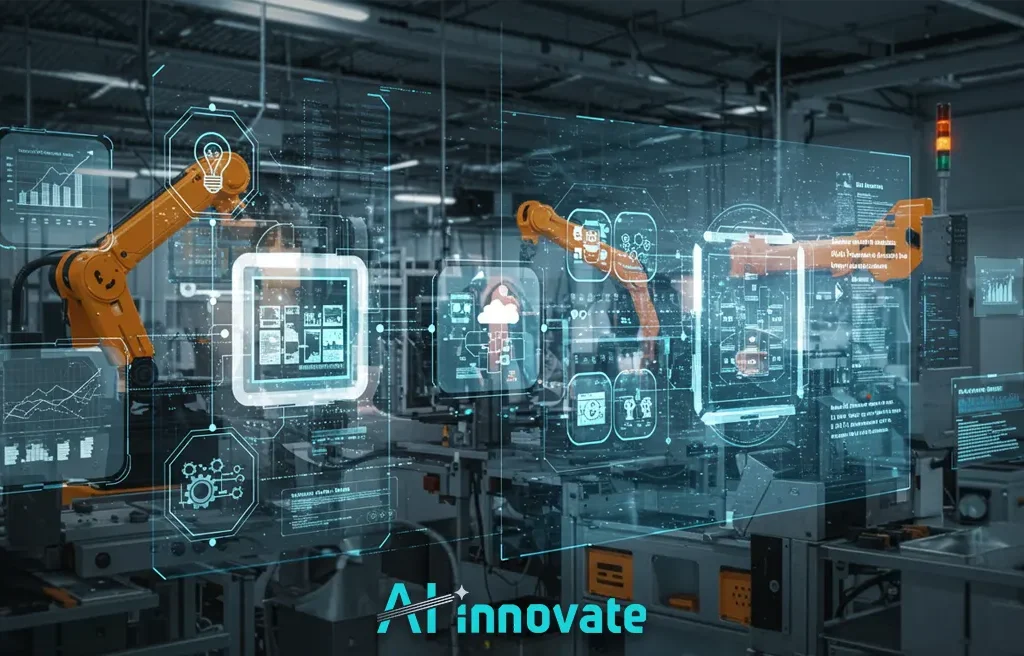
The Digital Twin of Quality
True optimization moves beyond rejecting bad parts to preventing them from being made in the first place. The rich data extracted from vision systems serves as the foundation for a “Digital Twin of Quality”—a dynamic, virtual model of your production line’s health.
This is a core tenet of effective Machine Learning for Manufacturing Process Optimization. By feeding this stream of defect telemetry into the broader operational data ecosystem, manufacturers can finally connect the dots between cause and effect.
Integrating with Operational Systems
The key is integration. When the output from an AI inspection system is linked with data from Manufacturing Execution Systems (MES) and SCADA, it creates a powerful analytical framework.
Now, a specific type of surface flaw can be directly correlated with a pressure fluctuation, a temperature spike, or a particular batch of raw material. This level of Process Monitoring provides unprecedented visibility into operational dynamics.
Unlocking Root Cause Analysis
With an integrated data model, manufacturers can move from reactive problem-solving to proactive, data-driven optimization. Instead of asking “What is wrong with this part?”, engineering teams can now ask “Which specific set of machine parameters correlates with the highest yield?”. This intelligence empowers teams to fine-tune their processes with surgical precision, reducing waste before it ever occurs.

Simulating the Factory Floor
For the ML engineers and R&D specialists tasked with building these advanced systems, the development process itself presents a significant bottleneck. A heavy reliance on physical camera hardware for prototyping and testing creates costly delays.
Procuring, configuring, and managing a diverse array of cameras to simulate different inspection scenarios is inefficient and stifles the pace of innovation. Software-based camera emulators offer a transformative solution. These tools provide a flexible virtual environment where developers can achieve the following:
- Reduced Hardware Dependency: Prototype and test algorithms for dozens of camera models without a single piece of physical hardware.
- Faster Iteration Cycles: Quickly simulate different lighting conditions, resolutions, and product variations to build more robust models.
- Seamless Remote Collaboration: Allow globally distributed teams to work from a single, consistent development environment.
This is precisely the challenge met by AI-Innovate’s ai2cam, a powerful tool designed to break down hardware barriers and streamline the path to deploying robust AI for quality assurance.
Blueprint for Smart Integration
Deploying a successful Machine Learning for Manufacturing Process Optimization strategy requires more than just advanced software; it demands a holistic, technically sound approach.
A successful integration hinges on a clear implementation blueprint that considers the entire ecosystem, from data acquisition to operational workflow. This ensures the system is not only powerful but also robust, scalable, and sustainable.
A prevailing challenge in industrial AI is the initial scarcity of comprehensive defect data for training. An advanced and highly effective strategy involves creating hybrid models. This technique merges data-driven neural networks with first-principal models derived from material physics and engineering knowledge.
The physics-based model simulates an ideal process baseline, while the machine learning component excels at identifying and learning the complex, non-linear deviations from this norm, drastically accelerating the system’s accuracy and reducing its dependence on massive historical datasets.
- High-Quality Dataset Curation: The performance of any AI model is directly tied to the quality of its training data. This requires establishing a rigorous process for collecting, cleaning, and meticulously labeling representative images of both acceptable products and a wide spectrum of defect types.
- Seamless OT Integration: The vision system must communicate fluently with existing Operational Technology (OT) like PLCs and MES. This ensures automated triggering of inspections, seamless data logging, and the ability to automatically divert faulty products without manual intervention.
- Intelligent Hardware Selection: The choice of camera, lens, and lighting is not trivial. It must be engineered specifically for the application, considering factors like product geometry, line speed, and the specific nature of the defects to be identified.
- Sustaining Human Expertise: A successful deployment is not a one-time event. It requires nurturing in-house expertise or partnering with specialists for ongoing model calibration, retraining, and system maintenance to ensure peak performance over time.
Engineering Financial Wins
For manufacturing leaders, the adoption of advanced technology must ultimately translate into tangible financial outcomes. An effective strategy for Machine Learning for Manufacturing Process Optimization excels here, converting technical precision into measurable business value.
The case for machine learning in quality control is not built on abstract potential but on quantifiable improvements that directly impact the bottom line. It re-engineers quality from a center of cost to a driver of profitability.
The financial benefits are realized through concrete operational enhancements. Precise, high-speed detection dramatically lowers the cost of poor quality by minimizing scrap and reducing the labor-intensive need for manual rework.
Furthermore, by preventing defective products from ever leaving the factory, companies see a direct reduction in the costs associated with warranty claims and product returns. These efficiencies culminate in a significant uplift in Overall Equipment Effectiveness (OEE) and a stronger Return on Investment (ROI).
Solutions from AI-Innovate, like our AI2Eye system, are engineered to deliver these measurable improvements, turning quality into a strategic advantage. Discover the tangible benefits at our website.
Conclusion
To thrive in today’s competitive landscape, manufacturers must move beyond the inherent constraints of human inspection. AI-powered vision systems represent this essential leap, providing the accuracy, speed, and data depth required for modern quality standards. Yet their true power lies not just in identifying flaws, but in generating the core intelligence needed for continuous process optimization. Integrating this capability is no longer an optional upgrade; it is a foundational component of efficient, resilient, and world-class manufacturing operations.


